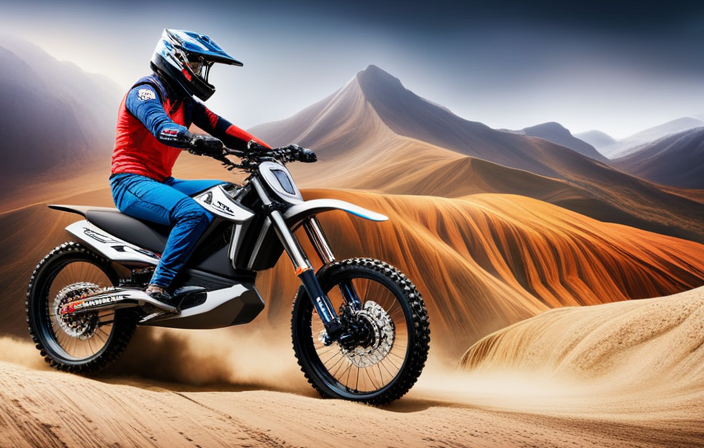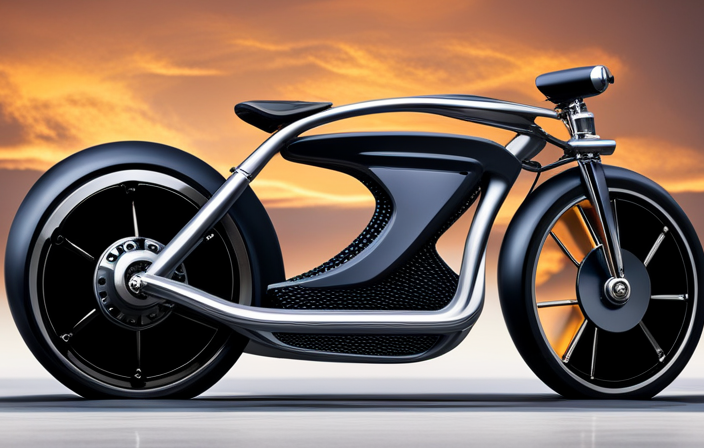Are you looking to turn your ordinary bike into an exhilarating electric ride? Look no more! In this article, we will walk you through the steps of wiring an electric bike.
By following our detailed instructions and gathering the necessary components, tools, and supplies, you’ll be able to connect the motor and battery effortlessly.
We’ll even show you how to troubleshoot any issues that may arise.
So, let’s get started and unlock the full potential of your electric bike!
Key Takeaways
- Pay attention to acceleration, braking, and overall handling
- Test the bike on different terrains and at various speeds
- Ensure smooth engagement of the motor
- Regularly inspect and maintain the bike’s wiring for safe operation
Choose the Right Components for Your Electric Bike Conversion
To choose the right components for your electric bike conversion, you’ll need to consider factors such as power output, battery capacity, and compatibility with your bike’s frame.
The power output of the motor determines how fast and how efficiently your electric bike will run. Higher power output means more speed and better performance.
Battery capacity is crucial as it determines how far you can ride on a single charge. Consider the range you want to achieve and choose a battery with enough capacity to meet your needs.
Compatibility with your bike’s frame is essential to ensure a proper fit and seamless integration. Take accurate measurements and research the specific components that will work best with your bike.
Once you’ve identified the right components, it’s time to gather the necessary tools and supplies for the installation process.
Gather the Necessary Tools and Supplies
Make sure you have all the tools and supplies you’ll need. Before you start wiring up your electric bike, it’s important to gather the necessary tools and supplies to ensure a smooth installation process. Here’s a checklist to help you get started:
-
Wire cutters and strippers: These tools will allow you to trim and strip the wires to the appropriate length.
-
Crimping tool: You’ll need this tool to securely attach connectors to the wires.
-
Soldering iron and solder: These are essential for creating strong and reliable connections.
-
Electrical tape: Use this to insulate and protect the exposed wires.
-
Heat shrink tubing: This will provide additional protection and ensure a neat and professional look.
Once you have all the tools and supplies ready, it’s time to familiarize yourself with the wiring diagram. This will serve as your guide throughout the wiring process, helping you understand the connections and components involved.
Familiarize Yourself with the Wiring Diagram
Take a few minutes to study the wiring diagram, as it will provide you with valuable information on the connections and components involved.
The wiring diagram is a visual representation of how the different electrical components of your electric bike are connected. It contains detailed information on the wires, connectors, and switches that make up the electrical system.
By studying the diagram, you can understand how the power flows through the system and how each component is interconnected. This knowledge will be crucial when it comes time to wire up your electric bike.
Disconnect and Remove the Necessary Parts
To begin the process of disconnecting and removing the necessary parts from your bike, start by removing the pedals and crankset.
This involves using a pedal wrench to loosen the pedals and then using a crank puller tool to remove the crankset.
Once the pedals and crankset are removed, you can then move on to disconnecting the brakes and shifters.
This requires loosening the brake cable tension and removing any bolts or connections that are holding the shifters in place.
Remove the Pedals and Crankset
First, you’ll need to unscrew the pedals and remove the crankset from your electric bike. Begin by using a pedal wrench to unscrew the pedals in a counterclockwise direction. Once the pedals are removed, you can move on to the crankset.
Start by loosening the bolts that hold the crank arms in place. This can usually be done with an Allen wrench or a specialized crank puller tool. Once the bolts are loose, carefully slide off the crank arms from the bottom bracket spindle. Be cautious not to damage any surrounding components.
With the crankset removed, you can now move on to disconnecting the brakes and shifters. This will allow you to fully prepare your electric bike for the wiring process.
Disconnect the Brakes and Shifters
Now that you have successfully removed the pedals and crankset, it’s time to move on to the next step: disconnecting the brakes and shifters. This step is crucial in order to ensure a smooth transition when connecting the motor and battery to your electric bike.
To disconnect the brakes and shifters, follow the steps below:
| Brake | Shifter |
|---|---|
| Left | Left |
| Right | Right |
- Start by locating the brake levers on the handlebars. These are usually positioned on the left and right sides.
- Use a wrench to loosen the bolts securing the brake levers.
- Once the bolts are loose, gently pull the brake levers away from the handlebars to detach them.
- Repeat the same process for the shifters, which are usually located next to the brake levers.
Connect the Motor and Battery
You’ll need to make sure that the motor and battery are properly connected before moving on to the next step.
Start by locating the motor wires and the corresponding connectors on the battery. Typically, the motor wires will have different colors to indicate their function, such as red for positive and black for negative. Match the colors and connect the wires securely, ensuring a tight fit to prevent any loose connections.
Once the motor and battery are connected, you can proceed to route and secure the wiring. This involves carefully organizing the wires along the frame of the bike, using zip ties or tape to keep them in place and away from any moving parts.
Pay attention to any areas where the wires may rub against the frame or other components, as this can cause damage over time.
Route and Secure the Wiring
To ensure the safety and functionality of your connections, carefully organize and secure the wiring along the frame of the bicycle. Proper routing and securing of the wiring is crucial to prevent any damage or interference while riding. Start by identifying the optimal path for the wires, ensuring they are away from moving parts and sharp edges. Use zip ties or cable clips to secure the wires along the frame, keeping them neat and taut. Make sure to leave enough slack for any necessary movements or adjustments. Additionally, consider using wire loom or electrical tape to protect the wires from the elements and potential abrasions.
| Tip 1 | Tip 2 |
|---|---|
| Route the wires away from | Use zip ties or cable clips |
| moving parts and sharp edges | to secure the wires along the frame |
Test the Connections and Troubleshoot Any Issues
Once you’ve finished securing the wiring, it’s time to test the connections and address any potential issues that may arise.
To start, turn on the power to your electric bike and check if all the components are functioning correctly. Ensure that the throttle responds smoothly and the brakes engage properly.
Next, test the motor by gradually increasing the speed. Listen for any unusual sounds or vibrations that could indicate a problem.
If everything seems in order, take your bike for a short test ride to further assess its performance. Pay attention to the acceleration, braking, and overall handling.
If you encounter any issues during the testing process, carefully inspect the wiring connections and troubleshoot the specific component causing the problem.
Once you have resolved any issues, you can proceed to reassemble and test ride your electric bike with confidence.
Reassemble and Test Ride Your Electric Bike
Now that you’ve successfully tested the connections and resolved any issues, it’s time to reassemble your electric bike.
Begin by carefully putting back all the parts that were removed during the troubleshooting process, making sure to secure them properly.
Once everything is back in place, take your electric bike for a test ride to ensure that all the components are functioning correctly and that the bike is performing optimally.
Put Back the Removed Parts
Start by carefully reattaching the parts that were previously removed. This step is crucial in ensuring that your electric bike is fully functional and safe to ride. Refer to the table below to guide you in putting back the removed parts correctly:
| Part | Location | Connection |
|---|---|---|
| Battery | Frame | Connect wires |
| Controller | Handlebar | Plug in cables |
| Motor | Rear wheel hub | Align and fix |
| Throttle | Handlebar | Attach securely |
Make sure to double-check all connections and ensure that they are tight and secure. Once you have successfully put back all the removed parts, you are now ready to take your electric bike for a test ride. It’s important to ensure that everything is working properly before going for a ride to avoid any potential issues.
Take Your Electric Bike for a Test Ride
Before hopping on, make sure to carefully check all the connections and ensure that they are secure and tight. Once you have completed the wiring process and put back all the removed parts, it’s time to take your electric bike for a test ride.
This will allow you to see if everything is working properly and if any adjustments or fine-tuning are needed. Start by turning on the power and checking if the motor engages smoothly. Pay attention to the throttle response and make sure it is responsive and in sync with your pedaling.
Test the brakes to ensure they are working effectively and smoothly. Take the bike for a spin, testing it on different terrains and at various speeds. This will give you a good idea of how well the wiring is functioning and if any further adjustments are required.
Maintaining and inspecting your electric bike wiring is crucial to ensure its longevity and safety.
Maintain and Inspect Your Electric Bike Wiring
First, make sure you regularly inspect and maintain the wiring on your electric bike. This is crucial for the safe and efficient operation of your bike. Here are four important steps to follow:
-
Check for any loose or frayed wires: Inspect all the wires on your electric bike to ensure they are securely connected and free from any damage. If you notice any loose or frayed wires, it’s essential to repair or replace them immediately.
-
Clean the wiring connections: Over time, dirt and debris can accumulate on the wiring connections, leading to poor conductivity. Regularly clean the connections using a small brush or compressed air to maintain optimal performance.
-
Protect the wiring from moisture: Moisture can cause corrosion and damage to the electrical components. Apply a waterproof sealant or use protective coverings to shield the wiring from water exposure.
-
Test the electrical system: Periodically test the electrical system of your electric bike to ensure all the components are functioning correctly. This includes checking the battery, motor, and any other electrical accessories.
Enjoy the Benefits of Your Electric Bike
Now that you have learned how to maintain and inspect the wiring of your electric bike, it’s time to dive into the exciting part – enjoying the benefits of your electric bike!
With your newly wired up bike, you can now experience the convenience and thrill of electric-powered transportation. Imagine effortlessly cruising through the city streets, feeling the wind on your face as you effortlessly glide past traffic. Uphill climbs are no longer a challenge, as the electric motor provides an extra boost of power.
Plus, you can explore more without worrying about getting tired or sweaty. Whether you’re commuting to work, running errands, or simply going for a leisurely ride, your electric bike will make every journey a breeze.
So get out there, embrace the freedom, and let your electric bike take you on unforgettable adventures.
Conclusion
Congratulations! You’ve successfully wired up your electric bike and you’re now ready to enjoy the incredible benefits it offers. Just imagine yourself zipping through city streets effortlessly, like a bird soaring through the sky.
With the right components, tools, and a little bit of know-how, you’ve transformed your ordinary bike into a powerful and efficient mode of transportation. So hop on, feel the wind in your hair, and embrace the freedom and excitement of your electric bike journey.
Keep those wires maintained and inspected, and let the adventures begin!









